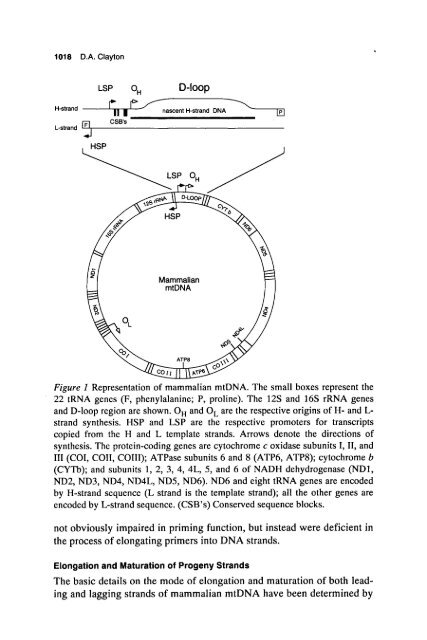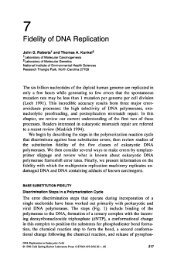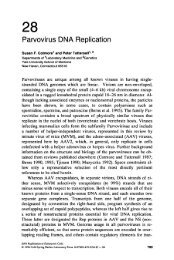Chapter 39: Mitochondrial DNA Replication (PDF)
Chapter 39: Mitochondrial DNA Replication (PDF)
Chapter 39: Mitochondrial DNA Replication (PDF)
You also want an ePaper? Increase the reach of your titles
YUMPU automatically turns print PDFs into web optimized ePapers that Google loves.
101 8 D.A. Clayton<br />
H-strand<br />
r;l CSB'S<br />
L-strand<br />
J<br />
, HSP<br />
LSP OH D-lOOp<br />
r<br />
nascent H-strand <strong>DNA</strong><br />
w<br />
I<br />
Mammalian<br />
mt<strong>DNA</strong><br />
Figure I Representation of mammalian mt<strong>DNA</strong>. The small boxes represent the<br />
22 tRNA genes (F, phenylalanine; P, proline). The 12s and 16s rRNA genes<br />
and D-loop region are shown. 0, and 0, are the respective origins of H- and L-<br />
strand synthesis. HSP and LSP are the respective promoters for transcripts<br />
copied from the H and L template strands. Arrows denote the directions of<br />
synthesis. The protein-coding genes are cytochrome c oxidase subunits I, 11, and<br />
I11 (COI, COII, COIII); ATPase subunits 6 and 8 (ATP6, ATP8); cytochrome b<br />
(CYTb); and subunits 1, 2, 3, 4, 4L, 5, and 6 of NADH dehydrogenase (ND1,<br />
ND2, ND3, ND4, ND4L, ND5, ND6). ND6 and eight tRNA genes are encoded<br />
by H-strand sequence (L strand is the template strand); all the other genes are<br />
encoded by L-strand sequence. (CSB's) Conserved sequence blocks.<br />
not obviously impaired in priming function, but instead were deficient in<br />
the process of elongating primers into <strong>DNA</strong> strands.<br />
Elongation and Maturation of Progeny Strands<br />
The basic details on the mode of elongation and maturation of both leading<br />
and lagging strands of mammalian mt<strong>DNA</strong> have been determined by






